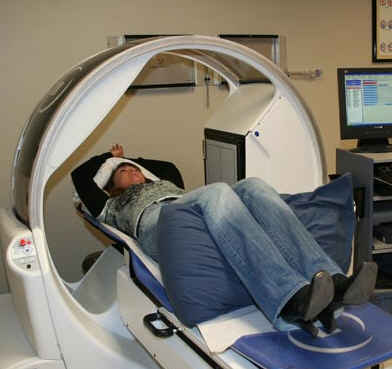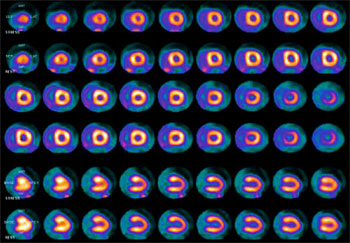 Nuclear Stress Testing
Nuclear Stress Testing, specifically
single photon emission computed tomography or SPECT, is a non-invasive nuclear imaging procedure used to evaluate for
abnormalities in coronary artery blood flow.
BCS Heart offers on-site Nuclear Stress
Testing.
Red blood cells traveling through coronary
arteries are responsible for delivering oxygen to the heart in order for the heart to function appropriately.
Abnormalities, or blockages, in these arteries may exist due to coronary artery disease and impair necessary oxygen
from reaching the heart.
Nuclear Stress Testing involves obtaining pictures of the heart following the injection of a radioisotope. This test is
used to assist physicians in the diagnosis and management of coronary artery disease. SPECT imaging is similar to Cardiac PET Scanning in that both imaging techniques
involve the use of a radioisotope and the detection of gamma radiation. With SPECT imaging, however, the measured
gamma rays are being directly emitted from radioisotopes, whereas with PET imaging, the measured gamma rays are
being generated from positron emisson. One imaging modality is not necessarily better than the other, although higher
resolution images are typically able to be generated with PET scanning.
For more detailed information about the procedure, continue
reading below.
Following placement of an IV and injection of a radioisotope, images of the heart are obtained by using a specialized
scanner (see picture above). Scanning the heart takes less than 10 minutes. Following the initial scan, the patient's
heart is stressed either through exercise or with the administration of a medication (regadenoson) to dilate, or
expand, the heart arteries.
 After the stress portion of the exam, a second scan of the heart is performed. The images obtained from the first
and second scans (see image to the right) are then compared and interpreted by your physician. Images are
able to provide detailed information about the function of the heart (ejection fraction), movement of the heart (wall
motion), and blood flow to the heart.
After the stress portion of the exam, a second scan of the heart is performed. The images obtained from the first
and second scans (see image to the right) are then compared and interpreted by your physician. Images are
able to provide detailed information about the function of the heart (ejection fraction), movement of the heart (wall
motion), and blood flow to the heart.
The patient is monitored by electrocardiogram throughout the procedure and the
entire procedure is completed within 3 hours.
Results of the procedure are typically available within 7-10 business days.

 Nuclear Stress Testing, specifically
single photon emission computed tomography or SPECT, is a non-invasive nuclear imaging procedure used to evaluate for
abnormalities in coronary artery blood flow.
BCS Heart offers on-site Nuclear Stress
Testing.
Nuclear Stress Testing, specifically
single photon emission computed tomography or SPECT, is a non-invasive nuclear imaging procedure used to evaluate for
abnormalities in coronary artery blood flow.
BCS Heart offers on-site Nuclear Stress
Testing.
 After the stress portion of the exam, a second scan of the heart is performed. The images obtained from the first
and second scans (see image to the right) are then compared and interpreted by your physician. Images are
able to provide detailed information about the function of the heart (ejection fraction), movement of the heart (wall
motion), and blood flow to the heart.
After the stress portion of the exam, a second scan of the heart is performed. The images obtained from the first
and second scans (see image to the right) are then compared and interpreted by your physician. Images are
able to provide detailed information about the function of the heart (ejection fraction), movement of the heart (wall
motion), and blood flow to the heart.